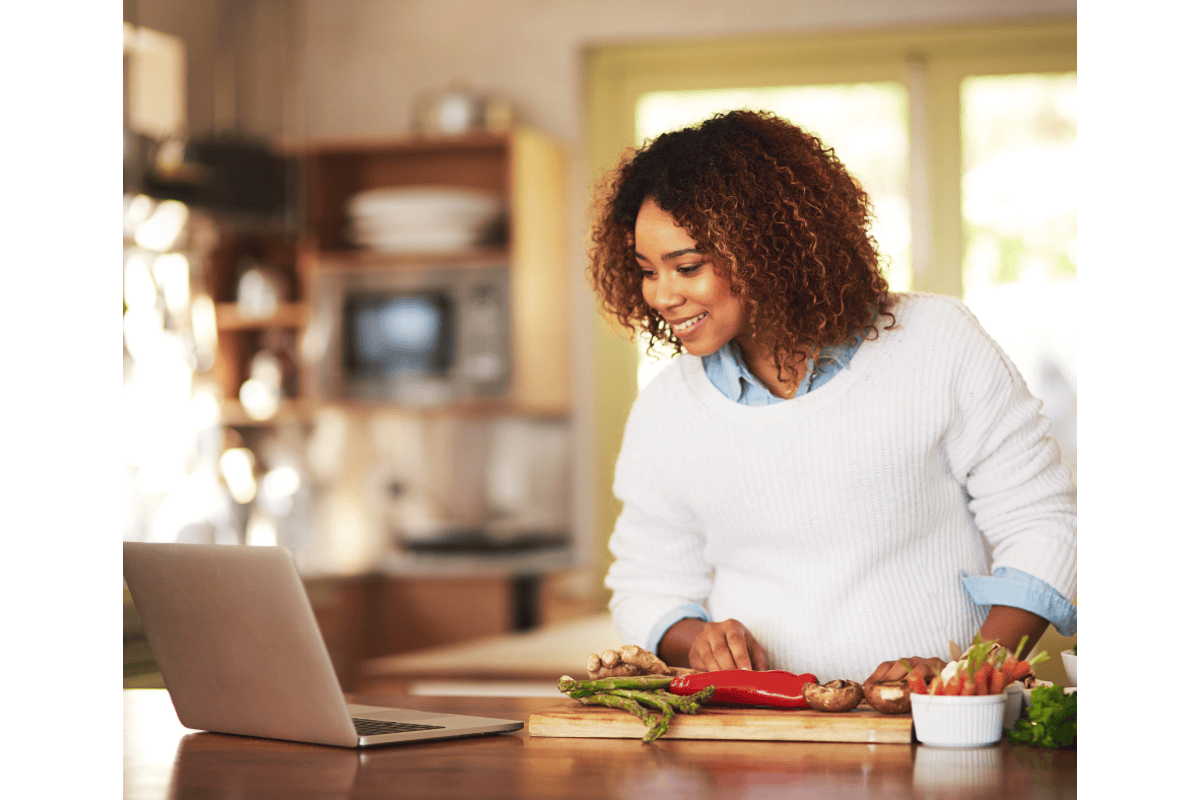CFCWR Blog

Using AI to help with household meal planning and other food tasks: The Good, the Bad, and the Ugly
Written by: Melissa Pflugh Prescott, Co-Director, Center for Food Conservation and Waste Reduction
Let me tell you about one of my most dreaded social interactions. I’m at a neighborhood potluck, and someone comes up to me and says, “You’re a dietitian, right? Can you make me a diet plan?” Argggh. It’s true that I have training and expertise to do this, but that doesn’t mean I can just spit out someone’s perfect diet plan in a matter of minutes. It turns out that, like most challenges today, people are increasingly turning to ChatGPT and other AI/LLMs (or large language models) to meal plan, create a shopping list, and assist with other household food management tasks.
In this blog post, I am going to explore the good, the bad, and the ugly of using AI to help you manage your food tasks.
The Good: What can AI do for you?
By now, we have all probably heard about the virtues of AI assistance. Even if you don’t use ChatGPT or other LLMs, you have probably noticed the AI Overview listed at the top of your results screen after a web search. These AI summaries can reduce your web search time by quickly curating a list of ideas and recipe links that feature a specific ingredient that you need to use before it spoils, or perhaps suggest ways to cook chicken so that it is moist yet safe to eat. But what about more complex tasks?
Many journalists, bloggers, and Redditors have described their experiences using AI to help them in the kitchen. Meal planning and shopping lists seem to be the most common AI-assisted food activities. The consensus seems to be that a simple LLM command is insufficient to create a useful shopping list or meal plan, frequently yielding results that do not meet dietary needs, such as leaving out entire food groups from a meal plan or recommending meals and snacks that provide too little food to fuel an active lifestyle. The popular opinion on Reddit seems to be that simple AI queries don’t work. Typically, multiple rounds of follow-up commands are required to provide worthwhile results. For example, you can tell LLMs to add more fiber to your meals, make half your meals use plant-based proteins, or replace expensive proteins with cheaper ones. One Reddit user shared their prompt for “The Ultimate Meal Planning and Grocery List Prompt for ChatGPT.” Other Redditors tried out the 1,338-word prompt and reported largely positive results.
The Bad: What are the common pitfalls?
Like all AI assistance, you run the risk of hallucinations. This occurs when AI gives you false information without indicating there is any uncertainty in the response. In my online research, I most often encountered hallucinations related to food prices, both generally and at specific grocery store chains. Furthermore, LLM responses to prompts are often prone to biased, unhealthy, and incorrect responses due to the nature of its training data. For example, one user’s prompt for a gluten-free meal plan yielded a diet that was very low in carbohydrates and calories, as well as deficient in key vitamins and minerals. This was attributed to the fact that the LLM was already informed of the user’s female gender, and disordered eating patterns were likely common among the online data that were used to train the LLM. So, even when AI doesn’t purposely give false information, it may yield incorrect results and reinforce negative or biased online communication.

To me, this suggests that AI help for complex food tasks (e.g., meal planning, shopping list development) may not be appropriate for those with little food and nutrition knowledge (aka poor food literacy or food resource management). You need to have some foundational food and nutrition knowledge to craft appropriate prompts and follow-up questions, as well as to detect false information. Those who lack this knowledge may go over food budgets, require extra trips to the grocery store, waste more food, or diminish their diet quality by blindly following LLM guidance.
The Ugly: Scary environmental impacts
So you might be thinking, wait, I thought that last bit was already ugly? Well, yes, it was, but there’s more…. AI-generated information may seem the same as a Google search, but it isn’t. Traditional search queries link the user to existing data from the internet. LLM prompts and the AI Overviews provided by search engines result in the creation of new information, which requires much more computing power. In other words, these and all other generative AI tools are massive electricity guzzlers. Goldman Sachs estimated that an average ChatGPT query uses almost 10x as much electricity compared to a Google search. Huge amounts of power are necessary to train, use, and fine-tune, requiring data centers to power them. An estimated 50 gigawatt-hours of energy were required to train OpenAI’s GPT-4, which is enough to power the entire city of San Francisco for 3 days. AI models have a short life span, often requiring updates at least 4x a year, and each update requires additional surges of energy consumption.
AI environmental impacts include freshwater use, e-waste, and natural resource degradation. Chilled water is used to cool data centers by absorbing heat from computing equipment. Think about how hot your laptop or phone can get when it’s overworked, and then scale that up to a data center the size of 1,700 football fields, like Meta’s newest data center in Louisiana. Each kilowatt hour of energy a data center consumes requires about 2 liters of water for cooling. A mid-sized data center uses about 300,000 gallons of water a day, which is roughly the same amount used by 1,000 U.S. households, with reports of disruptions to the water supply of neighboring homes and exacerbating water scarcity around the world.
Alternatives to AI assistance
AI is not the only option to streamline household food tasks. I like to simplify meal planning by having themed days for dinner each week, such as Meatless Monday, Taco Tuesday, Slow-Cooker Wednesday, and Improv Friday. The latter is when we upcycle leftovers and other food that needs to be eaten, without using a recipe. We really enjoy improv cooking because it makes leftovers exciting and new. Having a standing improv or leftovers night eases meal planning but also reduces waste. We also have one night each week where we make the current family favorite – right now it’s puttanesca with a (roasted) side of whatever veggies are on sale that week. Standing meal nights reduce the cognitive load required for meal planning – narrowing down options to make meal planning less of a brain burner.
Some Reddit users reported having a group text or Facebook Messenger chain dedicated to sharing recipes and meal ideas so that they can inspire each other and share optimal recipe alterations and recommendations with their loved ones. There are also loads of helpful tips in our resource library. For example, check out Still Tasty for guidance on how to store your food and Leftovers Revolution to help you make next-level leftovers.
Conclusion
AI assistance tends to be successful in two scenarios: If you already have a diet plan from your registered dietitian that outlines your specific energy and nutrient needs, you can put this information into an LLM to make your meal plan or shopping list. Alternatively, you can use a long and detailed AI prompt with follow-up prompts to refine the results. However, the amount of natural resources required for AI use increases as the prompts get longer and really balloons as the LLM’s response to prompts lengthens.
Our human brains have some commonalities with generative AI. Just like the training required to make LLM models useful, each time we engage in a food task, we are sharpening our brain’s ability to respond to any food-related situation (e.g., prompts) that we encounter. We have the choice to sharpen AI’s ability to get better or to hone our own cognitive power for food tasks. Perhaps, there is a happy medium somewhere, but in my personal and professional experience, there is real value in the pride, self-confidence, and satisfaction that come with having the knowledge and skill to make your loved ones something delicious out of something that would have gone to waste or been a bore to eat.
Bottom line, managing household food tasks in a way that benefits your health and your wallet takes a surprising amount of mentality, whether from human brains or LLMs. Either way, it seems like AI will not save me from additional diet plan requests at my next BBQ!
This work is supported by the Agriculture and Food Research Initiative, project award no. 2024-68015-42110, from the U.S. Department of Agriculture’s National Institute of Food and Agriculture. Any opinions, findings, conclusions, or recommendations expressed in this publication are those of the author(s) and should not be construed to represent any official USDA or U.S. Government determination or policy.
